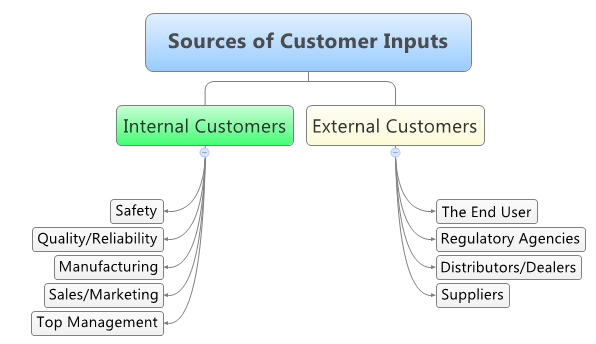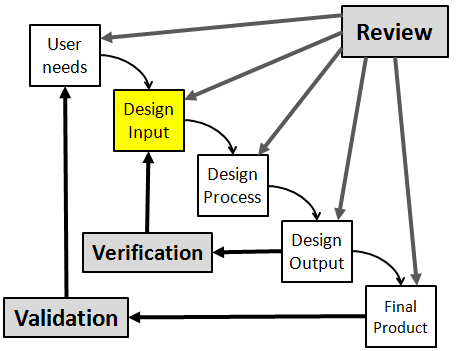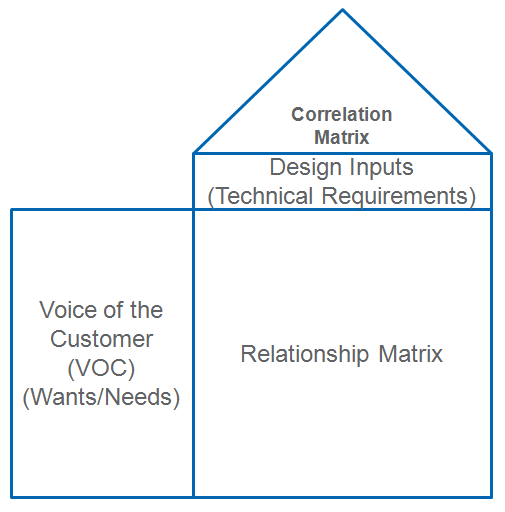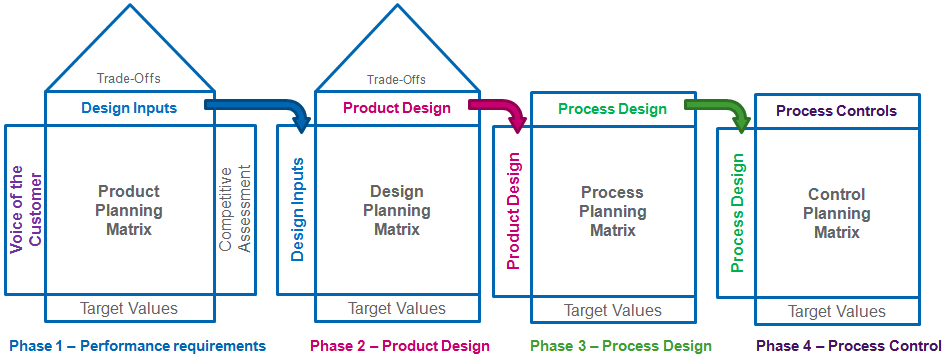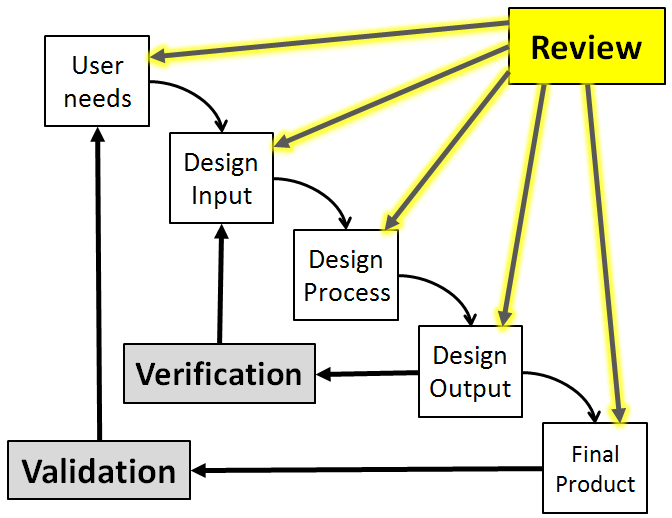 As Quality Engineers we get the exciting opportunity to support the development of new products or services.
As Quality Engineers we get the exciting opportunity to support the development of new products or services.
Product or Process Design, like everything else, is a process. Oftentimes, companies will call this their New Product Development Process.
This chapter will cover the 3 critical steps to designing a product that your customers will rave about!
- The first step in creating raving fans is to identify all the sources of design inputs & then capture their needs/wants & expectations! These design inputs will become your design targets.
- The next major step is the process of transform your customers needs (design inputs) into an epic design concept using tools like Quality Function Deployment (QFD), Robust Design, Design for X (DFX), Design for Six Sigma (DFSS) & Quality by Design.
- Finally, you must utilize the design review process throughout the development process to periodically confirm that you’re still on track to deliver an epic product.
By doing these three things really well, you will ensure that your customers needs & wants are fulfilled by your products design.
This process of capturing design inputs & reviewing that design at periodic intervals (design review) has been shown to be so valuable, that it has become an ISO 9001 requirement.
Sources of Design Inputs
Like I said above, developing a new product is like everything else you work on – it is a process, and all processes, no matter what the goal is, are all basically the same. There are inputs, a process and an output.
Designing a new product is no different. To ensure that your output (final product) is appropriate (or epic), you must start by determining all of your inputs (design inputs) because they will guide & drive the design process.

In the design process, your inputs are your generally your customers needs/wants/etc. These are the things (features, performance, reliability, quality, etc) that your customers find valuable and thus are willing to pay for.
Before you can determine what your customers needs and expectations are you must first understand WHO your customers are, because every organization or product has way more than just one customer (the end user).
In fact, every organization actually has two different types of customers: Internal Customers and External Customers.
Most people are familiar with their external customers – these are your end users and even your intermediate users (dealers, distributors, brokers, etc).
If you’re in a regulated industry (and which ones aren’t these days), you’ll have Regulatory Agencies as another type of external customer.
 Your other customer, those internal ones, are extremely important when you’re designing a new product, process or service.
Your other customer, those internal ones, are extremely important when you’re designing a new product, process or service.
For example, the manufacturability of your design or the serviceability of your design are very important to your internal customers (the manufacturing team or the service team)- much more in this below.
This chapter covers the 3 key topics that will help you to capture & interpret your customers needs & expectations; the Kano Model of Customer Satisfaction, Juran’s Classification of Customer Needs & Customer-Defined Value.
What are Design Inputs
Simply put, your design inputs are the technical reflections of your customers needs and they represent your customers requirements for the final product relating to safety, performance, functionality, quality, reliability and the intended use of your product.
Your design inputs can also capture any regulatory requirements or internal requirements driven by the organization.
The FDA popularized the waterfall design model that is common in the medical device industry where you’ll notice that the first step is the translation of User Needs into Design Inputs.
You may also notice that your Design Inputs then become the requirements that must be met by the final design concept and represent the acceptance criteria for Design Verification.
In this way, your design inputs will guide you when making all of the difficult design trade-off decisions during the design process.
Translating Design Inputs into Design Concepts
Once you’ve captured all of your design inputs, you’ll then need to go through the process of translating those needs into potential design concepts and then applying the right design methodologies to ensure that your final product is optimized to meet your customer needs.
Many of the design concepts below start by capturing the voice of the customer and then translating those wants/needs into the technical inputs that drive the final design concept.
Within this section you’ll learn about the 5 most common design methodologies that are used to deliver high quality products, these are:
- QFD (Quality Function Deployment)
- Robust Design
- Design for X
- Design for Six Sigma
- Quality by Design
QFD (Quality Function Deployment)
QFD is probably the most common tool used to translate customer needs into design inputs and design characteristics.
This exercise is accomplished using the most popular QFD tool, the House of Quality.
With this methodology, the Voice of the Customer (Wants/Needs, etc) are captured on the left side of the house, and along the top of the House are the design inputs (the technical requirements).
In the middle of the house is the Relationship Matrix which compares the Customer Needs to the Design Inputs to measure the relationship of each Design Input to each Customer Need.
A correlation matrix is the roof of the house which compares the relationship of different (potentially conflicting) product features. This will reveal any competing design inputs.
While most people are familiar with the House of Quality, the full QFD process takes a multi-phased approach that translates your customer needs all the way down to process control requirements, all of which are meant to consistently deliver your design inputs, shown below.
Robust Design
Robust Design was developed by the Quality Guru Genichi Taguchi as one of his Taguchi Methods for Quality Engineering to improve the Quality of manufactured goods.
Taguchi was an engineer and statistician that took a mathematical approach to Quality. Robust Design, or Robustification, is one of his most famous contributions to the field of Quality.
Robust Design, like some of the other methods that we’ll study in this chapter, is all about variation and the impact that variation has on your product or process.
Both your product and your production process will experience variation, and this variation will take two forms; Controllable variation and uncontrollable variation.
Uncontrollable variation is also called noise or random variation.
Robust Design is the process of studying and measuring both forms of variation and then optimizing your design to reduce the impact that uncontrollable variation has on the final product, and selecting the right parameters for your controllable variation (optimal set point and allowable range).
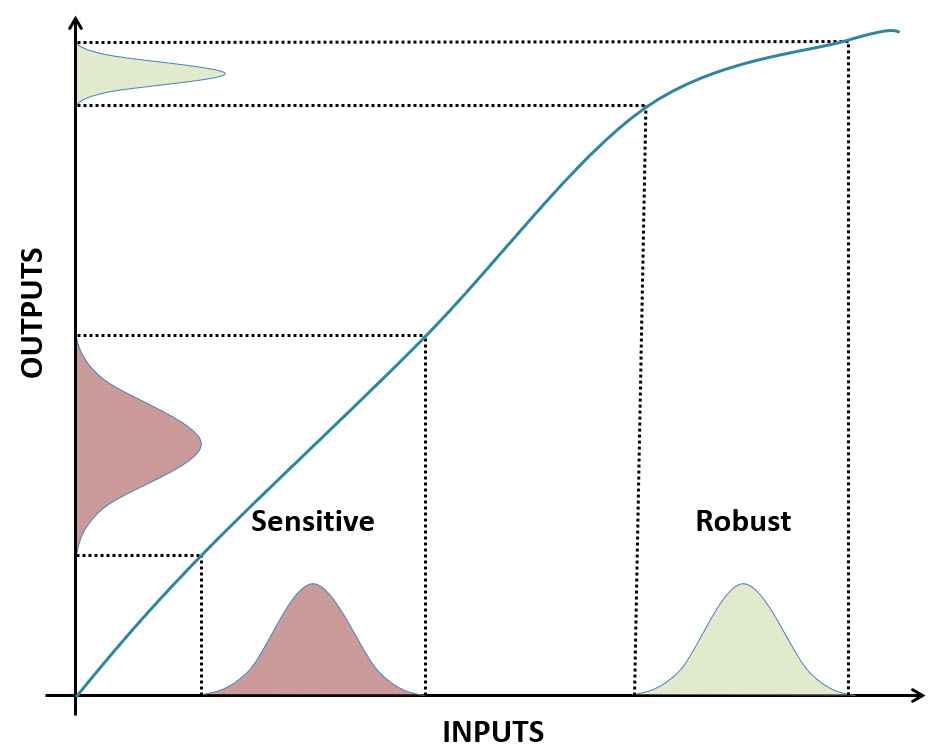
Studying Uncontrollable Variables (Noise)
The environment is one of the most frequently used examples of uncontrollable variation.
Many times, we as product designers cannot control the types of environments that our products will be exposed too.
What we oftentimes can control is the response that our product exhibits when it is exposed to varying environments.
Essentially, we’re optimizing our products design so that the uncontrollable variation (environment) does not impact Quality (performance, functionality, etc).
Using Robust Design to Determine your Optimal Process Parameters
The second element of Robust Design is the study of controllable variation to determine the optimal nominal value for each control variable (process parameter, starting material dimensions, etc) and the allowable ranges of variation for the process and the raw material.
Again, the goal is to ensure that the quality level of the final product is unaffected by the allowable range of our controllable variation.
The Robust Design methodology is similar to Quality by Design (discussed below), in that we are attempting to deliver a high quality product through the identification and control of all sources of variation.
Taguchi’s Robust Design process is very dependent on the usage of Designed Experiments to study variation, and quantify its impact on product quality.
This is done through the intentional variation of controllable variables, uncontrollable variables & your process inputs (materials, etc) to study their effects on the quality of the final product.
These DOE’s will allow you to determine the optimal setup point and ranges for your controllable variation and materials.
Design for X
Another common tool used during the conceptual stage of product development is Design for X.
Design for X was originally called Design for Excellence and has since evolved into a collection of unique methodologies where the X can stand for the different design perspectives, which include:
- Design for Manufacturing & Assembly
- Design for Reliability
- Design for Maintainability & Serviceability
- Design for Life Cycle Cost
- Design for Environment
- Design for Testing
One of the hallmarks of Design for X is Concurrent Engineering, where a product and its process are developed in parallel with the goal to integrate the unique methodologies above for improved reliability, manufacturability, life cycle cost, etc.
This concurrent engineering requires cross-functional teams and can significantly reduce the time required to develop a product or service. For each of the approaches below, the design team would include subject matter experts from those areas.
Design for Manufacturing & Assembly
Design for Manufacturing and Assembly is an approach meant to do just what the title implies, design your product such that it is easily manufactured & assembled.
To achieve this, the cross-functional design team should include subject matter experts from manufacturing, operation, engineering & supply chain.
Below are the 6 best practices that are generally utilized when designing for manufacturability & assembly:
- Reduction in the total number of parts
- Use of a modular design
- Use of standard, off the shelf components
- Designing components that are easily handled or manipulated
- Reducing tight tolerance or unnecessary part finishes
- Use error-proofing techniques to reduce waste
Design for Reliability
This design approach includes collaboration with your organizations Reliability Engineers to ensure that the design concept is optimized for reliability (Quality over time).
This approach generally includes an in-depth review of the different failure points of the proposed design concept using hazard analysis tools like FMEA, FTA, FRACAS along with prototype testing. This analysis will reveal your designs weaknesses – and where you can then make design changes to optimize the design for reliability.
Improving design reliability will reduce warranty costs, increase product safety, increase product performance & ultimately increase customer satisfaction.
Design for Maintainability & Serviceability
When designing large scale equipment that will require servicing & maintenance throughout the products lifecycle, it is very beneficial, financially, to optimize your design for maintainability and serviceability.
This can reduce downtime associated with repairs, reduce the life cycle cost associated with maintenance, eliminate hazards to technicians during repair & improve customer satisfaction. Essentially, this approach enhances your service teams ability to diagnose, remove, replace or repair your product back to its original condition with ease.
Design for Six Sigma (DFSS)
Design for Six Sigma, or DFSS is the application of the Six Sigma Methodology & tools to the development of products or processes with the goal of increased customer satisfaction and increased product robustness.
Where traditional six sigma is used for process improvement, DFSS is used during the design phase of a products lifecycle. Other than this though, the two methodologies are similar in many regards.
Similar to Six Sigma, the DFSS process utilizes statistical analysis to translate The Voice of the Customer into a robust product design that satisfies those needs while at the same time being optimized for the variation that the product may be exposed too.
Essentially, designers can use DFSS to bake in many of the 6σ tools for process improvement into the product design or process design stage of a project.
With traditional six sigma, practitioners use the DMAIC process to execute improvements, with DFSS there are many different “roadmaps” that can be used. The two most common DFSS roadmaps are DMADV & IDOV, both are shown below.
[table id=25 /]
[table id=26 /]
Both of these approaches (DMADV, IDOV) include a collection of tools & techniques that are meant to deliver an optimal product to your customers in a short amount of time as possible using effective & efficient design processes.
The DFSS approach, whether it’s Define in DMADV or Identify in IDOV starts like every other design process – by capturing the needs/wants & expectations of your customers. DFSS calls these customer needs your CTQ’s or Critical to Quality.
These CTQ’s are utilized throughout the design process to steer the design and drive key decisions to ensure that the final product is aligned with the customers needs. These CTQ’s are also cascaded down through the product into the process to align it with the customer needs as well.
Once the CTQ’s are established, DFSS uses common statistical tools & techniques to translate those needs into different, potential design concepts to be studied & measured to determine the optimal design concept.
Once a final design concept has been chosen, many DFSS road maps (DMADV & IDOV) will move into an optimization phase to further refine that design concept into a world class product.
Below is a table showing the IDOV road map with a list of the common tools or techniques that can be used within each stage of the design process.
[table id=27 /]
The final stage of any DFSS is the Verification/Validation stage, where the final design concept is tested to confirm that it meets all of the customers needs & intended use, etc.
Benefits of DFSS
DFSS allows organizations to avoid many of the common problems that DMAIC or Six Sigma attempt to solve once a product is in production. These are variation problems, waste problems, customer complaint issues, warranty issues, etc.
Essentially, DFSS is a Prevention activity meant to eliminate problems before they begin by designing in Quality.
DFSS can also result in shorter development cycle times, increasing speed to market and increasing market share as a result.
Quality By Design
If you remember back to the Quality Philosophies chapter, you’ll remember that Joseph Juran had a philosophy on Quality, and he called it his Trilogy – this included Quality Planning, Quality Control & improvement.
Juran’s concept of Quality Planning has evolved into a set of tools & techniques known as Quality by Design, which I’ll summarize as a 3 step process, but actually involves a whole lot of effort and analysis:
Step 1 – Identify your products Critical Quality Attributes (CQAs) – other methodologies call these CTQ’s, but essentially these are the Product Attributes or Characteristics that, when they are present they ensure the functionality, performance, safety & reliability of the final product.
Your CQA’s must be controlled within a given range to ensure product quality.
Step 2 – Identify the Process Parameters & Material Inputs whose variability can impact any of your CQA’s. These can be determined through the usage of DOE’s to measure this relationship.
This second step is all about variation. Specifically, the activity of studying & measuring variation; then controlling that variation or reducing the impact that any residual variation has on the final product.
Step 3 – Develop a control strategy to ensure that your material inputs & process parameters are sufficiently monitored and that your final product contains all of the critical quality attributes that your customer requires.
This control strategy, or control plan should include your starting materials, process parameters & your measurement/inspection points that confirm the presence of your CQA’s.
CQA’s can also be used as your acceptance criteria when you execute your process validation or supplier qualification. You can also calculate your process capability (Cp or Cpk) for these Critical Quality Attributes.
These three steps must all be conducted during product & process development, so that you are prepared for full scale production, but the Control Strategy or Control Plan that you develop will support on-going production throughout your products lifecycle.
In recent years the FDA has places a strong emphasis on QbD – especially in the pharmaceutical industry. This began with the recognition that Quality cannot be inspected into a product – Quality must be built into the product.
QbD is very much a preventative action that is meant to prevent issues from occurring, or at a minimum detect them when they do occur (via your control strategy).
The QbD approach is very similar to DFSS in that it’s all about identifying what’s critical to your customer, and ensuring that your process is designed to consistently deliver a high quality product.
The Design Review Process
As your design project progresses through the different stages of your design process, you should be intentional about scheduling & holding periodic Design Reviews.
Below is that waterfall model where I want to point out the design review that is conducted at the conclusion of each major stage. This is a very important element of the product design process.
The design review is an important opportunity for your cross-functional team members and independent reviewers to provide insight, wisdom and experience from other projects to the new design.
This design review, which is often held as a special meet, is an opportunity to review your design progress to ensure that you’re still on target to meet your customers needs.
Design Reviews, as a best practice, should be performed at planned & periodic milestones throughout the development period, typically at the completion of each design phase.
From a cost of quality perspective, the Design Review process is a preventative activity because it can help you identify failure before they occur and take the necessary action to prevent those problems.
YouTube Playlist
Below is a collection of some free youtube videos on the topic of Design Inputs, Design Review & the Design Optimization Methodologies that we’ve discussed here.
Conclusion
Whew – that was a long one! Ok, so to quickly recap, this chapter covered the 3 initial steps of the new product development process that are critical to your so organizations success as a business.
The first is to identify all of your different customers who will be sources of design inputs, and then effectively capturing your customers wants/needs & expectations too guide your design.
The next major step is the process of transform your customers needs (design inputs) into an epic design concept using tools like Robust Design, Quality Function Deployment (QFD), Design for X (DFX), Design for Six Sigma (DFSS) & Quality by Design.
Finally, you must utilize the design review process periodically to confirm that your design efforts are still on track to deliver an epic product.
When you’ve completed these three steps, you’ve done a lot of the heavy lifting that’s required for developing a new product. As you move through those design methodologies, you’ll also likely be required to create your detailed design output documents.
Your detailed design outputs include your the engineering drawings, product specifications & requirements, labeling requirements, bill of material, inspection criteria, and assembly procedures that describe your final product.
These outputs should be created in such a way that they clearly describe all of the components, assemblies & sub-assemblies of your product. These are
These design outputs will be verified during Design Verification to ensure that your product consistently deliver all of the Design Inputs that you created.
Your design outputs should also result in a final product that meets your customers needs. This requirement will also be confirmed during the Design Validation phase of development.
Your Design Outputs should also identify those product features that are essential for the proper functioning of the device – in some industries these are Critical Quality Attributes (CQA’s), or Critical to Quality (CTQs), or Critical Material Attributes (CMA’s).
One of the critical aspects of Design Output is the creation of your engineering drawings which are both a communication tool and a control tool to ensure that your product is manufactured & inspected consistently throughout its lifecycle. This topic is covered next in the next section, Technical Drawings & Specifications. n
